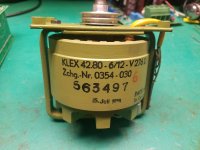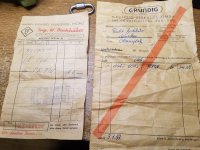Ah, thankyou, I'm glad I asked! I'll check the windings when I get around to the turntable, I suspect they are seperate inside the motor as currently the wires are joined on the board that contains the capacitor that provides the 90 phase shift.
I was not able to open the video you posted; maybe a link to it on YouTube?
You do not need the large caps on the output of the 7824 regulator; they should be BEFORE the reg. Normally, you only want 1-10uFd on the output and you want ripple free DC going into the reg.
Does the output voltage deviate if you start at another frequency such as 60Hz? If your mains frequency is 50Hz and there is a problem with the regulator configuration, the 100Hz ripple will create a beat frequency with the output as it moves away from 50Hz.
Hi Pyramid,
Large caps has been exchanged to the recommended values. I have stable 24 volts on the output (just as before).
What I have observed until now:
If I factory reset the controller and measuring directly on the output I can see a stable voltage- 238 volts. Once I change the frequency from 60HZ to 49.88 hz the voltage is starting to play with 12 volts (plus minus). It is dropping to 226 then goes back to 238. Exactly the same behavior if i lower the voltage via the SG4 setting.
What is strange that this goes only for 33 setting. No deviations in the voltage for 45.
Do you want me to make any special measurements on any spot so that you can help me to debug?
Currently I cannot use the controller in this state as I see very big deviations in speed. 33,10 to 33,45
But why the speed is not constant? I thought the stable frequency is important for the stable speed of the platter and not the voltage.
So just to make sure I give as much information as possible:
1. The voltage to SG4 - exactly 11.97 volts DC (toroidal transformer: 45VA)
2. The voltage to the Power amplifier - exactly 23.92 volts DC
3. The output from the SG4 (0) measures 1.755 VAC stable
4. The output of the amplifier is deviating from 13.90 VAC to 14.50VAC. this is only for 33 setting of the toggle switch open. It measures strong voltage of 14.50 VAC for 45 mode.
Please help.
Without a scope it is going to be difficult to tell what is happening. I suspect something with the power supply to the power amp. I've never tried to parallel two 1 amp regulators, I'm not sure that is a good idea. Can you find a 24VDC supply that is rated for 2A or more to use for testing? MeanWell makes a 2.5A 24VDC SMPS for <$20 that will power this project.
Also, I see you are using a 35VA toroid on the output. If your motor on the 401 is less than 25W, you should be able to run it from the transformer I spec'd (Amgis L01-6362). I've had problems with the TDA7492 amplifiers when using higher power toroids on the output.
Also, I see you are using a 35VA toroid on the output. If your motor on the 401 is less than 25W, you should be able to run it from the transformer I spec'd (Amgis L01-6362). I've had problems with the TDA7492 amplifiers when using higher power toroids on the output.
Last edited:
Yes, it will, very well. that motor, being a 6/12 pole one will run at 600rpm when wired for 12 pole at 60Hz. The only problem you will have is the voltage/power requirement.
If it's a 115V motor it will deliver more than enough torque when fed by a 65/75V supply, but you'll probably need at least 25W/phase. I use 3 x 60VA transformers and 3 x 200W class D amps.
WONDOM 3 X 200W Class D Audio Amplifier Board - T-AMP module 3 Channel amp | eBay
If it's a 115V motor it will deliver more than enough torque when fed by a 65/75V supply, but you'll probably need at least 25W/phase. I use 3 x 60VA transformers and 3 x 200W class D amps.
WONDOM 3 X 200W Class D Audio Amplifier Board - T-AMP module 3 Channel amp | eBay
Thank you for the response, Ralph.
That amp looks like a beast for the money. We are living in the future. With all that power maybe the motor can do double duty and also run my clothes washing machine.
600RPM will be perfect. I found a guy on eBay that seems willing to make spindle pulleys of about whatever spec I can come up with.
The paperwork just says 60cycle. lol. That probably means it's a 110V motor I guess. Ideally I'd like to ramp the voltage up slowly and find a happy spot rather than just feeding her all the jalapeños at once.
That amp looks like a beast for the money. We are living in the future. With all that power maybe the motor can do double duty and also run my clothes washing machine.
600RPM will be perfect. I found a guy on eBay that seems willing to make spindle pulleys of about whatever spec I can come up with.
The paperwork just says 60cycle. lol. That probably means it's a 110V motor I guess. Ideally I'd like to ramp the voltage up slowly and find a happy spot rather than just feeding her all the jalapeños at once.
Attachments
If you use the SG4 to provide the 3 phase signal then the 'ramp up' comes as standard. Without doubt the best DIY solution.
Ralph,
Does the SG4 do the ramp up automatically or is that what the reduced voltage adjustment is?
Thanks,
Scott
Does the SG4 do the ramp up automatically or is that what the reduced voltage adjustment is?
Thanks,
Scott
Yes, the output of the SG4 ramps up from 0 to 5V over the first half a second or so. This is done to hopefully avoid shutting down the subsequent amplifiers if they are expected to drive a low impedance load. Its not designed to allow for a slow ramp up of speed to avoid belt slippage.
Don't worry about ramp up speed, the Papst motors have characteristics that naturally ramp up over a few seconds. I'm running a slightly smaller motor that takes about 6 seconds to spin up a 5kg platter with no slip whatsoever. I am running my 110v motor at around 65V and its more than happy and hardly gets warm at all
60WPC Class AB drive for a 3W motor?
I think maybe overkill, as the turntable motors by design would have as low power as possible, in the order of 3W.
A small and cheesy Class-D audio amp should do the job fine of driving a little motor.
I think maybe overkill, as the turntable motors by design would have as low power as possible, in the order of 3W.
A small and cheesy Class-D audio amp should do the job fine of driving a little motor.
That's not the case with the Papst 3 phase motors. They are notoriously inefficient, and even the smaller ones draw around 20+ Watts. My larger unit draws 24W/phase, when driven at 120V, but only around 13W/phase at 65V.
I think maybe overkill, as the turntable motors by design would have as low power as possible, in the order of 3W.
A small and cheesy Class-D audio amp should do the job fine of driving a little motor.
60WPC is what the devices are rated for at maximum output into 8Ω (or 4Ω). The load seen by the amp will vary depending on the power requirement of the motor. A 3W 115VAC motor will have a winding resistance of ~4.4K. Using a 12V xfmr to step up the voltage of the amp will transform that impedance to ~75Ω (as seen by the amp output), so the power required by the amp will be much smaller. A 60WPC audio amp is appropriate for this application because of the thermal capabilities of the chips and the voltages needed to drive a xfmr primary to 115VAC under load. The amp is also running close to maximum output voltage all the time unlike audio which has a crest factor.
Last edited:
Not in this case, when adjusted optimally its very difficult to tell if the Papst motor is running while holding it in your hand
Right, audio average power is very low, crest at least 10X.
I have not (yet) measured my 3W rated motor under load, I suppose it will be maxed out at startup and much less later.
Class AB bias current would be a main culprit for heat generation, while not in itself a problem, but heatsinks, size and cost may be.
The transformer secondary voltage is irrelevant, the load is on the primary. Motor stall current would be a concern.
Can you still get the programmed chip for this project?
I have not (yet) measured my 3W rated motor under load, I suppose it will be maxed out at startup and much less later.
Class AB bias current would be a main culprit for heat generation, while not in itself a problem, but heatsinks, size and cost may be.
The transformer secondary voltage is irrelevant, the load is on the primary. Motor stall current would be a concern.
Can you still get the programmed chip for this project?
- Home
- Source & Line
- Analogue Source
- 60 WPC Amplifier for DIY Turntable Motor Drive

